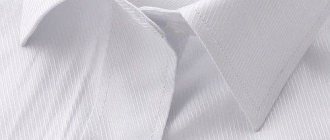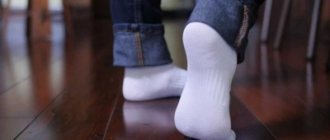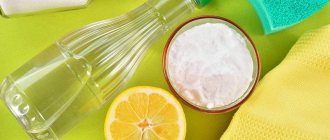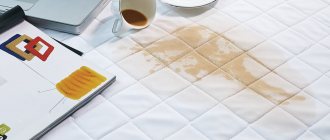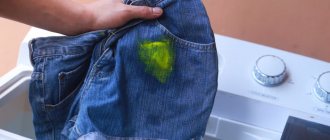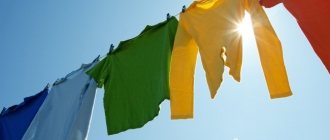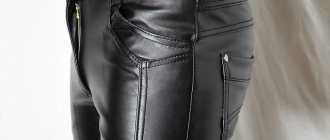What to do if things are stained. First measures
Any item of clothing can fade . Washing new wardrobe items, clothes made from bright fabrics, wool or denim can cause unwanted staining. Proper organization of washing and distribution of items helps reduce the risk of damage.
If such a situation occurs, do not panic.
The product can be saved if you immediately use proven methods:
- Boiling. Under the influence of high temperature, the paint is washed out of the fabric. This is one of the most effective methods, but it is not suitable for all types of fabric. Some materials may become deformed.
- Repeated washing . It is necessary to remove all things that can shed. It is better to wash the item of clothing separately. Active powder and the maximum temperature allowed by the tag on the clothing will help restore the original appearance of the products.
- Bleaching . This method is only suitable for white products.
Advice! It is important to act quickly and immediately after painting. Drying your clothes and ironing them will cause the dye to bond even more firmly into the fibers of the fabric. After this, it will be much more difficult or simply impossible to remove it.
How to wash printed items
If a design is applied to clothing using film printing, then such an item can be safely washed using any special means, the white will become brighter, and the design will be more beautiful and clearer. Only these things cannot be boiled so that the film does not peel off. This applies to clothing where the design is printed on a white background. If you take clothes made of dark fabric with a white pattern applied to it, then the use of bleaches will wash out the dye and the clothes will take on a sloppy appearance and ruin the color base.
For whitening white clothes with colored patterns, the special “Vanish for colored clothes” gel is perfect. It is available in both powder and liquid form. In addition, every store selling household chemicals has an excellent Anti-Pyatnin product. With its help, you can not only remove various stains from the fabric, but also whiten the yellowness from sweat on the white areas of the fabric.
Use it as follows:
- you need to rub a white cloth with it and leave for half an hour;
- rinse clothes with clean, cool water;
- wash according to instructions on label.
The peculiarity of “Antipyatnin” is that when it comes into contact with a colored drawing, it does not harm it, but only enhances the richness of the colors. In addition to chemicals, you can also use old home methods: add peroxide and ammonia (2 tablespoons each) when washing and pour 4 tablespoons of baking soda into the washing basin. Things will become dazzling white, and the colors will not fade.
If the clothes have an asymmetrical color, when bleaching, place a plastic bag inside under the pattern so as not to spoil the clothes on the reverse side.
We use special equipment
Home remedies can help remove faded stains, but only if used immediately after dyeing. If stains are noticed late, then specialized products and stain removers will come to the rescue.
The following household chemical products can be found on sale:
- "Antilin." Designed specifically to get rid of stains that appear as a result of shedding. It is effective for different types of fabric, but may slightly change the original color of the product.
- "Vanish." Helps restore whiteness not only to light-colored items, but also to remove difficult stains from colored items.
- Bleaches for light-colored items marked White . It is worth choosing the right product depending on the type of fabric.
- Korean products Paracle and Oxi Clean. Excellent for removing fade stains from brightly colored fabrics.
- Pasta Dr. Beckmann 3 in 1 . The product is applied using a sponge and is suitable for all types of fabrics.
Be sure to read:
How to bleach nylon tulle from gray and yellowness, the best way, reviews
How to bleach white clothes
White items require careful care. If white clothes are stained as a result of an unsuccessful wash, you should choose a cleaning method based on the type of fabric and care instructions on the item's label.
Natural fabrics
Items made from natural fabric must be washed again.
If stains remain, you can resort to the following methods:
- Boiling. White things are placed in a saucepan and boiled for 2-3 hours.
- Soaking in ammonia. For 5-6 liters of water take 1 glass of alcohol. It is enough to keep things in the solution for 1 hour.
- Soaking with hydrogen peroxide. Similarly, add 50 ml of peroxide to 5 liters of water and pour things in for 1 hour.
- A mixture of starch, lemon juice and salt. The ingredients are mixed in equal parts and diluted in a container with water until it becomes thick sour cream. Treat the stains with the resulting mixture and rinse thoroughly after half an hour.
- Potassium permanganate. The item should be soaked in a weak solution of potassium permanganate for 20-30 minutes.
Synthetic fabric
Synthetic clothing requires delicate care and does not tolerate too high temperatures, bright sunlight and chlorine-based chemicals.
To get rid of stains on synthetic items, you can use:
- Ammonia, laundry soap and hydrogen peroxide. Mix 5 tbsp. l. alcohol, 1 piece of soap and 2 tbsp. l. peroxide, dilute the ingredients in 10 liters of water. Soak the soiled wardrobe items in the resulting solution for 30 minutes. and rinse.
- Aspirin. 2 tablets are diluted with 1 glass of water and moistened with soiled areas. After 5 min. the item is washed in the usual way.
- Laundry soap. The damaged item must be immediately thoroughly soaped and soaked for several hours, then washed in the usual way.
Delicate items
The following methods are suitable for cleaning items made from delicate fabrics:
- Washing powder, ammonia, salt and hydrogen peroxide. Add 1 tbsp to 5 liters of water. l. each ingredient and soak the dyed items in the solution. After a couple of hours, the laundry should be rinsed well.
- Dry mustard (1 tbsp) is diluted in 1 liter of hot water. The mixture is infused for a couple of hours, then contaminated items are washed in it.
Be sure to read:
How to whiten a white blouse: 7 folk recipes if it has turned gray or yellowed
How to use bleach
Bleach is effective, but when using it you need to take into account some rules:
- it is better to apply them only to natural fabrics; when bleaching artificial materials, they may be useless,
- preference is given to bleaches that contain oxygen, since they are more effective and gentle,
- when washing by hand, it is recommended to pre-soak items with bleach for 6-8 hours,
- washing by machine is allowed if it is not prohibited by the tag on the clothes; when washing in a machine, it is better to use bleaches in the form of gels,
- on dense fabrics, treat problem areas with bleach, leave for 10-15 minutes, then wash.
Removing stains from multi-colored laundry
Stain removers are suitable for black clothes, but stain removers are not. When choosing a suitable product, pay attention to the composition and properties of the substance. If you are unsure how a product works, try it on a small, inconspicuous area or piece of fabric.
Alcohol
Removing white spots on the armpits from black clothes will help in the fight against alcohol or vodka. What to do:
First, dampen the stain with alcohol.
- Dampen the stain with alcohol (moisten it with a cotton pad).
- Wait a few minutes.
- Rinse and throw in the wash.
In most cases, the effect is visible immediately after application. Do not soak the substance on the fabric for more than an hour.
Vinegar
This method is not suitable for white clothes, as the vinegar solution may leave yellowish streaks. Therefore, vinegar should only be used on multi-colored and black clothing:
- Dampen dirty areas with vinegar.
- Leave it overnight.
- Rinse and wash clothes.
The vinegar solution is safe for most things. The liquid is safe for sofa upholstery and even woolen sweaters.
Dishwashing liquid
The gel removes fatty protein stains. What to do:
- Squeeze it onto the stain.
- Scrub, leave for half an hour.
- Rinse under running water.
- Wash as usual.
How to restore colored clothes
Items made from colored fabrics are usually washed together, so they suffer from shedding more often. Measures to restore their appearance also depend on the type of fabric.
Natural fabrics
The following methods are effective:
- Repeated wash on intensive cycle . Dyed clothing should be washed again at a higher temperature (if allowed on the tag) and with more detergent. So the thing will paint over itself.
- Ammonia. For 10 liters of water take 1 tbsp. l. substances. The item of clothing is soaked for 20 minutes, boiled and rinsed well.
- Washing powder with hydrogen peroxide. 50 g of powder is combined with 15 ml of peroxide and diluted with water. Soak the damaged item in the mixture for an hour and rinse.
Synthetic clothing
Help in cleaning items made from synthetic fabrics will be provided by:
- A mixture of lemon juice, starch and laundry soap . The ingredients are mixed in equal parts and applied to areas of contamination. After a couple of hours, the clothes are washed in the usual way.
- Repeated rinsing in clean water. Effective for fresh stains.
Delicate clothing
To remove stains from colored delicate fabrics, you can use a mixture of baking soda and vinegar. A tablespoon of baking soda is quenched with vinegar and applied to the stain. After an hour, rinse thoroughly.
Be sure to read:
How to wash towels: effective ways to bleach and clean terry materials
How to prevent staining
It is easier to follow the washing rules than to later remove stains from faded fabrics.
To avoid possible staining, the following washing recommendations should be followed:
- Wash white and colored items separately,
- do not combine washing items of clothing of radially different colors,
- do not wash clothes that are susceptible to shedding at high temperatures,
- wash new items separately,
- When washing in a machine, add color catchers or special dye fixing agents.
Causes of whitish spots on white
Surprisingly, white spots on white are quite possible. Most often they are made from cosmetics, sweat (they acquire a yellowish tint), and milk. Getting chalk dirty and white is a trivial task.
Whitish spots are not always visible on dry clothes. Soap bubble stains are completely invisible. However, they were found on washed laundry in the form of round dark spots. This is due to the interaction of glycerol in the alveolar fluid with detergent ingredients.
Yellowish streaks may appear during ironing. Clean the inside of your iron to remove any rust that gets onto your laundry during steaming.

